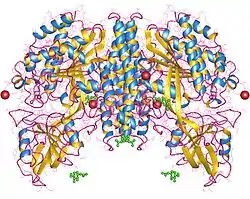Transferrin-Rezeptor 1
Der Transferrin-Rezeptor 1 (TfR1) ist im Eisen-Stoffwechsel ein transmembranes Transportprotein für Transferrin und dient zum Einschleusen von Eisen-Ionen in eine Zelle über eine Rezeptor-vermittelte Endozytose.[1]
| Transferrin-Rezeptor 1 | ||
|---|---|---|
 | ||
| Andere Namen |
T9, p90, CD71, TFRC | |
| Eigenschaften des menschlichen Proteins | ||
| Masse/Länge Primärstruktur | 760 Aminosäuren, 84.871 Da | |
| Bezeichner | ||
| Externe IDs | ||
| Orthologe (Mensch) | ||
| Entrez | 7037 | |
| Ensembl | ENSG00000072274 | |
| UniProt | P02786 | |
| Refseq (mRNA) | NM_001128148.2 | |
| Refseq (Protein) | NP_001121620.1 | |
| PubMed-Suche | 7037 | |
Bei niedrigen Konzentrationen an Eisenionen wird die Genexpression des Transferrinrezeptors über das IRE-BP (engl. iron response element binding protein) genannte Protein am Iron Response Element verstärkt, wodurch mehr Eisenionen in die Zellen gelangen.
Neben dem TfR1 existiert noch der Transferrin-Rezeptor 2.
Verwendung
Da der TfR1 auf vielen Zelltypen vorkommt, wurde er als Ziel für eine Rezeptor-vermittelte Transfektion verwendet.[2][3]
Literatur
- U. Testa, L. Kühn, M. Petrini, M. T. Quaranta, E. Pelosi, C. Peschle: Differential regulation of iron regulatory element-binding protein(s) in cell extracts of activated lymphocytes versus monocytes-macrophages. In: J. Biol. Chem.. 266, Nr. 21, Juli 1991, S. 13925–13930. PMID 1856222.
- T. R. Daniels, T. Delgado, J. A. Rodriguez, G. Helguera, M. L. Penichet: The transferrin receptor part I: Biology and targeting with cytotoxic antibodies for the treatment of cancer. In: Clin. Immunol.. 121, Nr. 2, November 2006, S. 144–158. doi:10.1016/j.clim.2006.06.010. PMID 16904380.
- T. R. Daniels, T. Delgado, G. Helguera, M. L. Penichet: The transferrin receptor part II: targeted delivery of therapeutic agents into cancer cells. In: Clin. Immunol.. 121, Nr. 2, November 2006, S. 159–176. doi:10.1016/j.clim.2006.06.006. PMID 16920030.
Weblinks
- MeSH Transferrin-Rezeptor 1
- M. Okam: Transerrin and Iron Transport Physiology. In: Information Center for Sickle Cell and Thalassemic Disorders. Brigham and Women's Hospital and Harvard Medical School. 29. Januar 2001. Abgerufen am 19. Dezember 2010.
Einzelnachweise
- Z. M. Qian, H. Li, H. Sun, K. Ho: Targeted drug delivery via the transferrin receptor-mediated endocytosis pathway. In: Pharmacological reviews. Band 54, Nummer 4, Dezember 2002, ISSN 0031-6997, S. 561–587, PMID 12429868.
- N. Düzgüneş, C. T. De Ilarduya, S. Simões, R. I. Zhdanov, K. Konopka, M. C. Pedroso de Lima: Cationic liposomes for gene delivery: novel cationic lipids and enhancement by proteins and peptides. In: Current medicinal chemistry. Band 10, Nummer 14, Juli 2003, ISSN 0929-8673, S. 1213–1220, PMID 12678795.
- U. Lungwitz, M. Breunig, T. Blunk, A. Göpferich: Polyethylenimine-based non-viral gene delivery systems. In: European journal of pharmaceutics and biopharmaceutics : official journal of Arbeitsgemeinschaft für Pharmazeutische Verfahrenstechnik e.V. Band 60, Nummer 2, Juli 2005, ISSN 0939-6411, S. 247–266, doi:10.1016/j.ejpb.2004.11.011, PMID 15939236.
This article is issued from Wikipedia. The text is licensed under Creative Commons - Attribution - Sharealike. The authors of the article are listed here. Additional terms may apply for the media files, click on images to show image meta data.